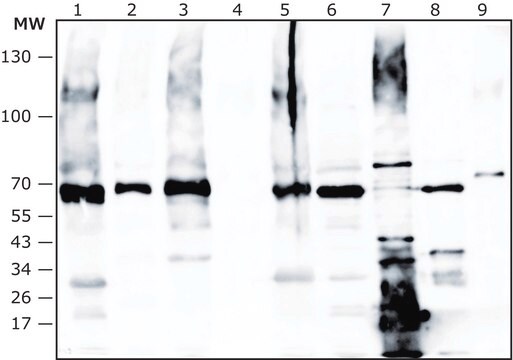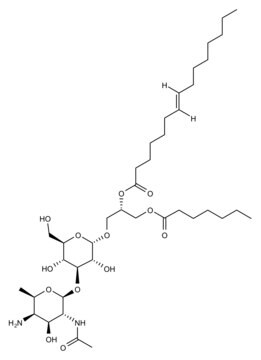SAB4200745
Anti-Protein A antibody, Mouse Monoclonal
clone SPA-27, purified from hybridoma cell culture
Synonyme(s) :
Anti-IgG binding protein A, Anti-SpA, Anti-Staphylococcal protein A, Anti-Staphylococcus ayreus protein A
About This Item
Produits recommandés
Source biologique
mouse
Niveau de qualité
Forme d'anticorps
purified from hybridoma cell culture
Type de produit anticorps
primary antibodies
Clone
SPA-27, monoclonal
Forme
buffered aqueous solution
Poids mol.
~42 kDa
Espèces réactives
Staphylococcus aureus
Concentration
~1.0 mg/mL
Technique(s)
dot blot: suitable
flow cytometry: suitable
immunoblotting: suitable
immunofluorescence: suitable
immunoprecipitation (IP): 2.5-5 μg/test using purified protein A from Staphylococcus aureus
indirect ELISA: 0.25-0.5 μg/mL using 10 μg/mL of protein A from Staphylococcus aureus for coating. To reduce nonspecific binding we recommend on detection using a secondary anti-mouse, F(ab’)2 fragment antibody
Isotype
IgG1
Conditions d'expédition
dry ice
Température de stockage
−20°C
Modification post-traductionnelle de la cible
unmodified
Description générale
Spécificité
Immunogène
Application
Actions biochimiques/physiologiques
Forme physique
Stockage et stabilité
Clause de non-responsabilité
Vous ne trouvez pas le bon produit ?
Essayez notre Outil de sélection de produits.
Code de la classe de stockage
12 - Non Combustible Liquids
Classe de danger pour l'eau (WGK)
WGK 1
Point d'éclair (°F)
Not applicable
Point d'éclair (°C)
Not applicable
Certificats d'analyse (COA)
Recherchez un Certificats d'analyse (COA) en saisissant le numéro de lot du produit. Les numéros de lot figurent sur l'étiquette du produit après les mots "Lot" ou "Batch".
Déjà en possession de ce produit ?
Retrouvez la documentation relative aux produits que vous avez récemment achetés dans la Bibliothèque de documents.
Les clients ont également consulté
Notre équipe de scientifiques dispose d'une expérience dans tous les secteurs de la recherche, notamment en sciences de la vie, science des matériaux, synthèse chimique, chromatographie, analyse et dans de nombreux autres domaines..
Contacter notre Service technique










